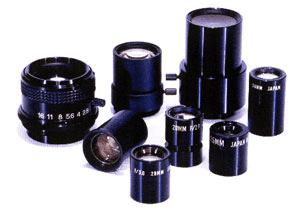High resolution lenses for machine vision — standard and custom lens design
The History Of Machine Vision Camera Technology
High Resolution Lenses for machine vision, instrumentation, inspection and vibration-sensitive applications. Standard and custom hi-res lens assemblies.

The History Of Machine Vision
Most living things and mechanical objects emit, reflect or transmit light of one kind. The light emitted is measured in electromagnetic spectrum (EM) by the frequency of EM radiation of the object. EM frequency is measured in wavelengths that range from the size of an atom to thousands of kilometers. Long wavelengths are low frequency and are radio, microwave and infrared waves. Short wavelengths are the frequency of ultraviolet, x-ray and gamma rays.
The optical spectrum, or visible spectrum, is the electromagnetic spectrum that is visible to the human eye. Visible spectrums have no clear boundaries from one color to the next but are defined in the following nanometer ranges:
- Violet 380-450nm
- Blue 450-495nm
- Green 495-570nm
- Yellow 570-590nm
- Orange 590-620nm
- Red 620-750nm
A nanometer is a unit of length in the metric system that is equal to one billionth of a meter.
In the optics field, light is described as infrared, visible and ultraviolet. Because light is an electromagnetic wave some optics emit electromagnetic radiation, this light is emitted from x-rays, microwaves and radio waves, among others.
In machine vision applications that incorporate camera technology, the optical fields of visible, ultraviolet and infrared lights are the most widely used. Specialized optics, filters and lighting bring solutions to imaging issues. Most cameras operate in the near IR or near UV wavelength range and through the use of specialized lighting (LED) and filters, the wavelengths can be enhanced.
Ultraviolet technologies are most prevalent in machine vision and industrial-imaging applications while IR camera technology is common in military applications. Digital cameras are also able to manipulate ultraviolet rays when taking photographs.
Universe Optics offers lens design and optical lenses for industrial, medical, high tech and electronic applications.